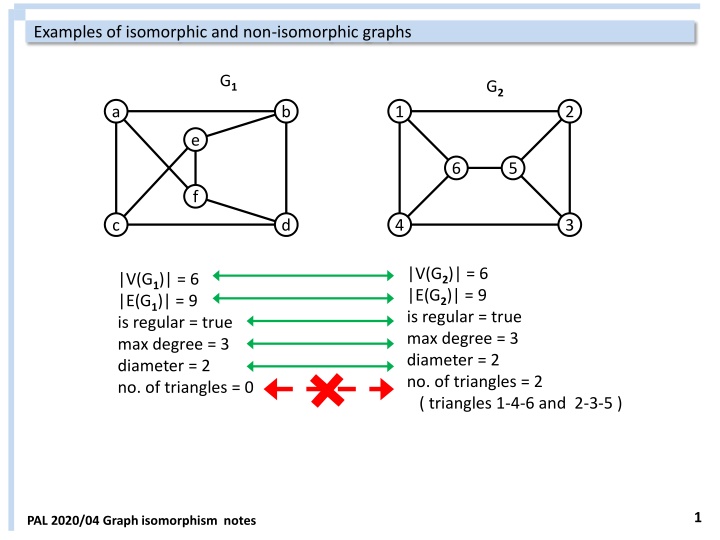
Graph Isomorphism: Examples and Concepts
Explore examples of isomorphic and non-isomorphic graphs, understand the concept of graph isomorphism, discover different properties to determine isomorphism, and learn through graphical representations and node mappings.
Download Presentation

Please find below an Image/Link to download the presentation.
The content on the website is provided AS IS for your information and personal use only. It may not be sold, licensed, or shared on other websites without obtaining consent from the author. If you encounter any issues during the download, it is possible that the publisher has removed the file from their server.
You are allowed to download the files provided on this website for personal or commercial use, subject to the condition that they are used lawfully. All files are the property of their respective owners.
The content on the website is provided AS IS for your information and personal use only. It may not be sold, licensed, or shared on other websites without obtaining consent from the author.
E N D
Presentation Transcript
Examples of isomorphic and non-isomorphic graphs G1 G2 a b 1 2 e 6 5 f c d 4 3 |V(G2)| = 6 |E(G2)| = 9 is regular = true max degree = 3 diameter = 2 no. of triangles = 2 ( triangles 1-4-6 and 2-3-5 ) |V(G1)| = 6 |E(G1)| = 9 is regular = true max degree = 3 diameter = 2 no. of triangles = 0 1 PAL 2020/04 Graph isomorphism notes
Examples of isomorphic and non-isomorphic graphs 1 b G1 G2 2 3 a c e d 4 5 |V(G1)| = 5 |E(G1)| = 6 min degree = 2 max degree = 3 degree sequence = [3 3 3 3 2] ... etc. |V(G2)| = 5 |E(G2)| = 6 min degree = 2 max degree = 3 degree sequence = [3 3 3 3 2] ... etc. ? ? The question remains: Are G1 and G2 isomorphic to each other? ? ? 2 PAL 2020/04 Graph isomorphism notes
Examples of isomorphic and non-isomorphic graphs 1 b G1 G2 2 3 a c e d 4 5 G1: Set of mapped edges: G1: Set of edges: G2: Set of edges: Nodes mapping: a --- 4 b --- 5 c --- 3 d --- 1 e --- 2 { {a e} {a b} {b c} {c e} {e d} {c d} {b d} } { {4 2} {4 5} {5 3} {3 2} {2 1} {3 1} {5 1} } { {1 2} {1 3} {1 5} {2 3} {2 4} {3 5} {4 5} } Both sets of edges are the same. G1and G2are isomorphic. (Verification: Sort all sets, compare items one by one.) G3 3 PAL 2020/04 Graph isomorphism notes
Examples of isomorphic and non-isomorphic graphs G2 G1 a b 1 2 3 c d e 4 5 6 7 f g h 8 9 10 11 i j k 12 13 14 |V(G1)| = 14 |E(G1)| = 16 degree sequence = [3 3 3 3 2 2 2 2 2 2 2 2 2 2] diameter = 7, ( distance(l, e) ) isBipartite = yes ... |V(G2)| = 14 |E(G2)| = 16 degree sequence = [3 3 3 3 2 2 2 2 2 2 2 2 2 2] diameter = 7, ( distance(4, 11) ) isBipartite = yes ... l m n The question remains: ? ? Are G1 and G2 isomorphic to each other? ? ? 4 PAL 2020/04 Graph isomorphism notes
Examples of isomorphic and non-isomorphic graphs G2 G1 a b 1 2 3 c d e 4 5 6 7 f g h 8 9 10 11 i j k 12 13 14 multisets of degrees of neighbours of nodes with degree 3: { {3 2 2} // d {3 2 2} // f {3 3 2} // g {3 3 2} } // j multisets of degrees of neighbours of nodes with degree 3: { {3 2 2} // 5 {3 2 2} // 6 {3 2 2} // 9 {3 2 2} } // 10 l m n G1 and G2 are not isomorphic to each other. Another Invariant: G1 -- nodes of degree 3 form a connected subgraph. G2 -- nodes of degree 3 form two mutually unconnected subgraphs. More invariants: Try yourself.... PAL 2020/04 Graph isomorphism notes 5
Difficulty Is there any set of properties which are (relatively) easy to calculate for any graph and which values would decide whether two given graphs G1, G2are isomorphic? In the sense: values calculated on G1== values calculated on G2 if and only if G1is isomorphic to G2 So far, no such set of properties is known in general. Partial solution Advanced heuristical approaches solve the problem in many practical settings: SW: nauty and Traces: https://pallini.di.uniroma1.it/ based on papers by Brendan D.McKay and AdolfoPiperno: Practical graph isomorphism I and II. http://citeseerx.ist.psu.edu/viewdoc/summary?doi=10.1.1.169.6684 https://arxiv.org/abs/1301.1493 6 PAL 2020/04 Graph isomorphism notes
Examples of isomorphic and non-isomorphic graphs Isomorphism is difficult to confirm/reject when the graphs are highly symmetric. Informally, symmetry means that a graph "looks the same" in the vicinity of each node. The number of candidate bijections is then difficult to reduce when there are no obvious invariants which values would help to distinguish between different nodes. As a simple example, consider the following pair of graphs. Picture credit to https://sagecell.sagemath.org and code g1 = graphs.CirculantGraph(19, [1,5,8] ); g1.show() g2 = graphs.CirculantGraph(19, [1,4,7] ); g2.show() 7 PAL 2020/04 Graph isomorphism notes
Isomorphism of directed graphs In these slides, term graph always refers to an undirected graph, if not specified otherwise. All isomorphism properties, algorithms, notions, etc. defined for undirected graphs, can be analogously defined and analyzed/solved in analogous manner for directed graphs. Two directed graphs G1=(V1,E1) and G2=(V2,E2) are isomorphic if there is a bijection f : V1 V2such that x, y V1 : (f (x), f (y)) E2 (x, y) E1 Example: G2 G3 G1 Graphs G1and G2 are isomorphic, G3is not isomorphic to any of G1, G2. 8 PAL 2020/04 Graph isomorphism notes
N Number f(N) of graphs on N nodes (incl. unconnected ones) https://oeis.org/A000088 1 1 N ( ) 2 2 N! 2 2 Approximation of the number of graphs: f(N) 3 4 4 11 5 34 6 156 f(N) ( ) 2 2 N! lim N = 1 The formula approximates f(N) tightly, in the sense: 7 1044 N 8 12346 9 274668 10 12005168 15 31426485969804308768 645490122795799841856164638490742749440 ~ 6.5 1038 3344943163092576692494395699280800289566314799353930643299678348872177345348 80582749030521599504384 ~ 3.3 1098 7793841167914977954582550817575177766066055272533160501864210580719699592280 7665987621085074589139360819329653520373728865932592867538838570163833079818 63462449691949358853053120648183808 ~ 7.8 10186 see inset 20 30 40 N Applying brute force and checking all graphs for would be a hopeless effort. 9 PAL 2020/04 Graph isomorphism notes
N Number f'(N) of connected graphs on N nodes https://oeis.org/A001349 1 1 2 1 3 2 4 6 5 21 6 112 7 853 8 11117 9 261080 10 11716571 15 31397381142761241960 20 645465483198722799426731128794502283004 3344942976179029274740625889887714205924003404484971757354867875739197630926 64433461017585013705594 7793841167347901373159586190645563996131177435680973666982243627070377497235 4174178748323987582425416768805527046107079810797229883124475331332011126406 04192083672776028633590109166374659 asymptotically same as all graphs, 30 40 in the sense: lim { N , f'(N) / f(N) } = 1 N Applying brute force and checking all graphs for would be a hopeless effort. 10 PAL 2020/04 Graph isomorphism notes
N Number f''(N) of undirected trees on N nodes https://oeis.org/A001349 1 1 2 1 3 1 4 2 5 3 6 6 7 11 8 23 9 47 10 106 15 7741 20 823065 14830871802 ~ 1.5 1010 363990257783343 ~ 3.6 1014 30 40 100 630134658347465720563607281977639527019590 N Formula is too complex to fit here, see the OEIS reference above Applying brute force and checking all trees would be a hopeless effort. 11 PAL 2020/04 Graph isomorphism notes
Examples of more graph invariants (a tiny! selection): (.) Connected - yes/no (.) Number of edges (.) Bipartite - yes/no (.) Regular - yes/no (the degree of all nodes is the same) (.) Tree - yes/no (.) Planar - yes/no (can be drawn in a plane without edges crossing) (X) Hamiltonian - yes/no (Hamilton path or cycle exists in the graph) (.) Maximum/maximum node degree (.) Number of nodes with maximum (minimum degree) (.) Degree sequence (sequence of all node degrees sorted in non-increasing order) (X) Spectrum (= multiset of eigenvalues) of adjacency (Laplacian) matrix of the graph (X) Length of the shortest cycle (so called girth of the graph) (X) Number of triangles (.) Number of bridges/cutvertices/blocks (X) Number of automorphisms (X) Chromatic/independence/dominancy/clique numbers (see respective definitions...) (X) Diameter, excentricity, number of centers (X) Bandwidth ... (.) O(E+V), (X) more complex than O(E+V), polynomial or exponential. 12 PAL 2020/04 Graph isomorphism notes
Two random graphs are extremely(!) probably NOT isomorphic When two graphs G1, G2 are selected randomly from the set of all graphs on N nodes or when they are generated randomly, then A. The probability that G1 and G2 are isomorphic is very close to 0. *) B. The probability that the values of some (in fact, of many) of invariants in G1 and G2 are different is very close to 1. A. Very probably, G1 and G2 are not isomorphic. B. Very probably, it is (relatively) easy to verify G1 and G2 are not isomorphic . Conclusion: When the graphs are not isomorphic, checking the values of various (easy to compute, preferentially! ) invariants in both graphs, quickly confirms the fact in majority of (random) cases. *) How close? The probability p is in the order of n! / 2comb(n,2). For example, n = 10, p = 10! / 245 10 7; n = 100, p = 100! / 24950 10 1332. 13 PAL 2020/04 Graph isomorphism notes
Tree certificate example 01 01 01 01 01 0011 0011 b 01 d c b a c 01 01 g f e 01 0011 g f e 01 01 k j h i j 01 01 01 01 001011 01 01 01 00011011 0011 00011011 b nondecreasing lexicographic order 00010111 0011 00010111 g f f 0000101110001101100111 000111 001011 14 PAL 2020/04 Graph isomorphism notes
Tree certificate example 0 1 f 01 01 01 01 d c b a 1 0 0 1 0 1 g b e 01 01 g f e 0 1 0 1 0 1 0 1 j c a i 01 k j h i 0 1 0 1 0 1 k h d 01 01 01 01 0000101110001101100111 0 0 0 0 1 0 1 1 1 0 0 0 1 1 0 1 1 0 0 1 1 1 15 PAL 2020/04 Graph isomorphism notes
Tree certificate example 01 01 01 01 0 1 d c b a f 1 0 0 1 01 01 g f e 0 1 g b e 01 0 1 0 1 0 1 0 1 k j h i j c a i 01 01 01 01 0 1 0 1 0 1 0000101110001101100111 k h d 0 0 0 0 1 0 1 1 1 0 0 0 1 1 0 1 1 0 0 1 1 1 Perform DFS from the root == center of the tree. Always expand DFS into that subtree which certificate is lexicographically the smallest. Output 0 when the node is being open and output 1 when the node is being closed. The output sequence is the tree certificate, it is obvious by induction. Drawback: DFS cannot know the subtrees certificates in advance. The idea can be used only for reconstructing the tree from the certificate. 16 PAL 2020/04 Graph isomorphism notes
Tree certificate example proc reconstructTree( certificate ) nodesList = emptyList() edgesList = emptyList() centers = emptyList() // one or two centers stack = emptyStack() 0 1 f 1 0 0 1 0 1 g b e for digit in certificate if digit == '0' create node X nodesList.add( X ) if stack.isEmpty() centers.add( X ) else edgesList.add( pair(stack.top(),X) ) stack.push( X ) else // digit == '1' stack.pop() 0 1 0 1 0 1 0 1 j c a i 0 1 0 1 0 1 k h d 0 0 0 0 1 0 1 1 1 0 0 0 1 1 0 1 1 0 0 1 1 1 0 1 0 1 f m 0 0 1 0 1 e1 0 1 g b i if centers.size() == 2 // two centers edgesList.add( pair(centers[0],centers[1]) ) return nodesList, edgesList, centers 0 1 0 1 1 0 1 0 j c a l 0 0 1 1 0 1 0 1 k h d n 0000101110001101110000111011 17 PAL 2020/04 Graph isomorphism notes
Tree certificate example - Python reconstruction def reconstruct( certificate ): nodes, edges, stack = [], [], [] centers = [] # 1 or 2 centers newNode = 0 # nodes are integers 0 1 0 1 f m 0 0 1 0 1 e1 0 g 1 b i for digit in certificate: if digit == '0': newNode += 1 # 'create' new node nodes.append( newNode ) if len( stack ) == 0: # empty centers.append( newNode ) else: edges.append( [newNode, stack[-1]] ) stack.append( newNode ) else: # digit == '1': stack.pop() 0 1 0 1 1 0 1 0 j c a l 0 0 1 1 0 1 0 1 k h d n 0000101110001101110000111011 if len( centers ) == 2: edges.append( [centers[0], centers[1]] ) return nodes, edges, centers cer = "0000101110001101110000111011" nodes, edges, centers = reconstruct( cer ) 18 PAL 2020/04 Graph isomorphism notes






















